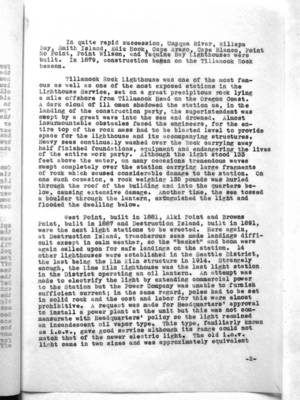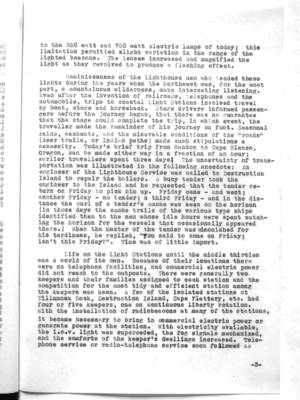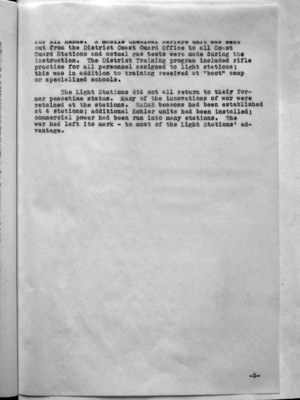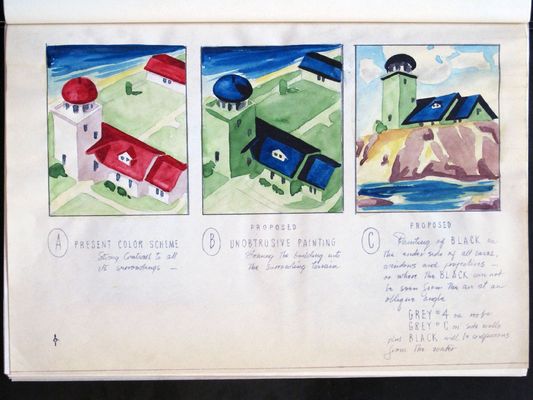Pages
21
In the quite rapid succession, Umpqua River, Willapa Bay, Smith Island, Ediz Hook, Cape Arago, Cape Blanco, Point No Point, Point Wilson, and Yaquina Bay Lighthouses were built. In 1879, construction began on the Tillamook Rock Beacon.
Tillamook Rock Lighthouse was one of the most famous as well as one of the most exposed stations in the Lighthouse Service, set on a great precipitous rock lying a mile offshore from Tillamook Head on the Oregon Coast. A dark cloud of ill omen shadowed the station as, in the landing of the construction party, the superintendent was swept by a great wave into the sea and drowned. Almost insurmountable obstacles faced the engineers, for the entire top of the rock mass had to be blasted level to provide space for the lighthouse and its accompanying structures. Heavy seas continually washed over the Rock carrying away half finished foundations, equipment and endangering the lives of the entire work party. Although the light stood 133 feet above the water, on many occasions tremendous waves swept completely over the station carrying large fragments of rock which caused considerable damage to the station. On one such occasion, a rock weighting 135 pounds was hurled through the roof of the building and into the quarters below, causing extensive damage. Another time, the sea tossed a boulder through the lantern, extinguished the light and flooded the dwelling below.
West Point, built in 1881, Alki Point and Brown Point, built in 1887 and Destruction Island, built in 1891, were the next light stations to be erected. Here again, at Destruction Island, treacherous seas made landings difficult except in calm weather, so the "basket" and boom were again called upon for safe landings on the station. 14 other lighthouses were established in the Seattle District, the last being the Lim Kiln structure in 1914. Strangely enough, the Lime Kiln Lighthouse was the last light station in the District operating an oil lantern. An attempt was made to electrify the light by extending commercial power to the Station but the Power Company was unable to furnish sufficient current; in the same regard, poles had to be set in a solid rock and the cost and labor for this were almost prohibitive. A request was made for Headquarters' approval to install a power plant at the unit but this was not commensurate with Headquarters' policy so the light remained an incandescent oil vapor type. This type, familiarly known as i.o.v., gave good service although its range could not match that of the newer electric light. The old i.o.v. light came in two sizes and was approximately equivalent
-2-
22
to the 350 watt and 750 watt electric lamps of today; this limitation permitted slight variation in the range of the lighted beacons. The lenses increased and magnified the light as they revolved to produce a flashing effect.
Reminicenses of the Lighthouse men who tended these lights during the years when the Northwest was, for the most part, a mountainous wilderness, make interesting listening. Even after the invention of railroads, telephones and the automobile, trips to coastal Light Stations involved travel by boat, stage and horseback. Stage drivers informed passengers before the journey began, that there was no guarantee that the stage could complete the trip, in which event, the traveller made the remainder of his journey on foot. Seasonal rains, washouts, and the miserable conditions of the "roads" (deer trails, or Indian paths) made such stipulations a necessity. Today's brief trip from Bandon to Cape Blanco, Oregon, can be made either way in a fraction of an hour; earlier travellers spent three days; The uncertainty of transportation was illustrated in the following anecdote: An engineer of the Lighthouse Service was called to Destruction Island to repair the boilers. A buoy tender took the engineer to the Island and he requested that the tender return on Friday to pick him up. Friday came - and went; another Friday - no tender; a third Friday - and in the distance the curl of a tender's smoke was seen on the horizon (in those days the smoke trails of the various type ships identified them to the men whose idle hours were spent watching the horizon for the vessels that occasionally appeared there.) When the Master of the tender was admonished for his tardiness, he replied, "You said to come on Friday; isn't this Friday?". Time was of little import.
Life on the Light Stations until the middle thirties was a world of its own. Because of their locations there were no telephone facilities, and commercial electric power did not reach to the outposts. There were generally two keepers and their families assigned to each station and the competition for the most tidy and efficient station among the keepers was keen. A few of the isolated stations at Tillamook Rock, Destruction Island, Cape Flattery, etc. had four or five keepers, one on continuous liberty rotation. With the installation of radiobeacons at many of the stations, it became necessary to bring in commercial electric power or generate power at the station. With electricity available, the i.c.v. light was superceded, the fog signals mechanized, and the comforts of the keeper's dwellings increased. Telephone service or radio-telephone service soon followed as
23
the construction of roads by the State Highway Departments made the outlying stations more readily accessible.
Seventy keepers were in residence on the Stations when the Lighthouse Service was consolidated with the Coast Guard in 1939. During the war, this number had increased to 176 on these stations. The increase was due, primarily, to the fact that unskilled men inducted into the Service had not the training, background, nor interest in the Station which was common to the men earlier assigned there. Furthermore, the work at the station increased during the war years; Coastal Lookout units with their dogs and horses were generally located on Station grounds. this necessitated turning the dwellings of the Keepers into barracks to quarter the increased personnel and building kennels, stables and shelters for equipment. The end of the war began the gradual reduction of the Stations to their normal peacetime complements.
Early in the war, the Commandant, 13th Naval District, ordered the concealment of ten of the Light Stations that were near military areas or war industries. The walls were "toned down" with gray and the space under the eaves painted black to accentuate the silouette of the Station as it appeared from the water. (Tongue Point Repair Base was provided with a camouflage net to cover the wharves where vari-colored buoys and markers were stored. This Base was in the vicinity of the Naval Air Station, Astoria, and the work was done in conjunction with assistance from that activity.) Army activities near Coast Guard units furnished the paint for camouflaging the structures. The last of the stations was returned to its normal peace time color by the end of the summer, 1945. (See sixth page for camouflage technique)
A continuous lookout adwatch was maintained by the Keepers of New Dungeness, Ediz Hook, Slip Point and Cape Flattery Lighthouses beginning, strangely enough, 6 December, 1941. All vessels, aircraft, or any suspicious activity (such as attempts at communications between persons on shore (such as attempts at communications between persons on shore and unidentified vessels) were reported to Naval Section Base at Port Angeles and the Harbor Defense, Fort Worden. This order directed that persons engaged in suspicious activity should be apprehended and taken into custody. However, this directive was rescinded and, rather than take such individuals into custody, observers notified the nearest Army or Navy intelligence who took the necessary action.
Drills in the use of the gas mask were held at all Light Stations and a course in Chemical Warfare was complusory
24
For All Hands. A mobile Chemical Warfare unit was sent out from the District Coast Guard Office to all Coast Guard Stations and actual gas tests were made during the instruction. The District Training program included rifle practice for all personnel assigned to light stations; this was in addition to training received at "boot" camp or specialized schools.
The Light Stations did not all return to their former peacetime status. Many of the innovations of the war were retained at the stations. RADAR beacons had been established at 4 stations; additional Kohler units had been installed; commerical power had been run into many stations. The war had left its mark - to most of the Light Stations' advantage.
25
(Image left)
(A) PRESENT COLOR SCHEME Strong Contrast to all its surrounds
(Image center)
(B) PROPOSED UNOBTRUSIVE PAINTING ??? the building into the surrounding terrain
(Image right)
(C) PROPOSED Painting of BLACK on The under side of all eaves, windows and projectives - or where the BLACK can not be seen from the air at an oblique angle
GREY #4 on the roofs GREY #C on side walls plus BLACK will be conspicious from the water




